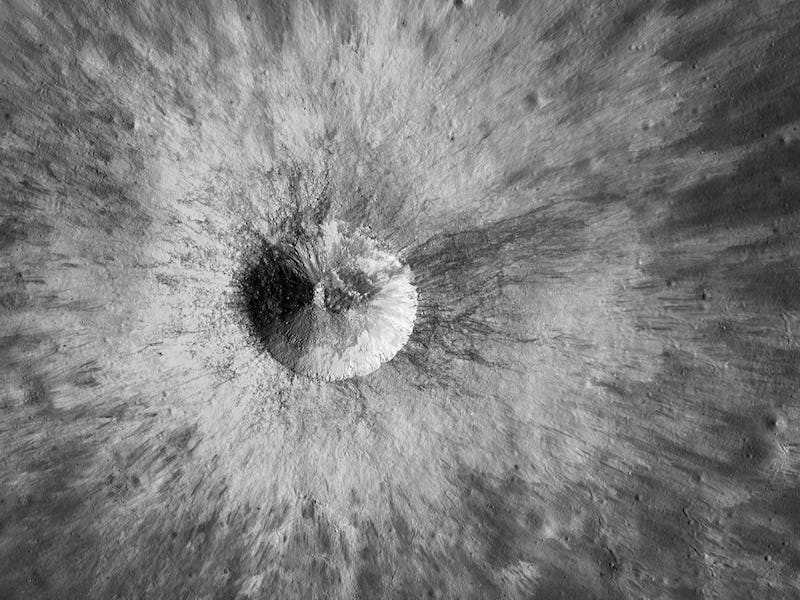50-year-old lunar volcanic glass could settle a debate about the Moon's origins
We are one step closer to finding out whether the Moon is made of the same stuff as Earth.

Billions of years ago, a cosmic cataclysm formed the Moon. But some of the details on what, exactly, happened in those historic moments remain fuzzy.
In a study published Wednesday in Science Advances, researchers took a closer look at samples of volcanic glass collected from the Moon more than 50 years ago by the Apollo missions. Using these precious pieces of lunar history, they recreated the series of events which followed the formation of the Moon and its core.
The findings may reveal the answer to a fundamental scientific question about the Moon's formation — and show whether Earth and the Moon are made up of the same stuff.
How did the Moon form?
HERE'S THE BACKGROUND — Some 4.5 billion years ago, the Solar System formed. As objects flung through the young planetary system, our own planet survived several massive impacts.
One such collision may have birthed the Moon. Scientists believe a massive object the size of Mars, known as Theia, collided with a young, developing Earth around 4 billion years ago. The collision tossed vaporized particles from Earth into space, so the theory goes, which then bound together through gravity to form the Moon.
This theory, known as the impact hypothesis, is one of three main theories of how the Moon formed. The other two suggest the Moon was either formed at the same time as Earth in situ, or that it was a wandering body captured by Earth's gravitational field.
One leading theory of how the Moon formed is that a now-destroyed proto-planet called Theia crashed into Earth and the resulting material mixed with molten materials from Earth to form the Moon.
One way to test these theories is to find out whether the Earth and the Moon have the same composition. If they do, then that would suggest they formed from the collision with Theia.
Alberto Saal, professor of Earth, Environmental, and Planetary Sciences at Brown University and lead author of the new study, believes the Moon formed from an impact, but tells Inverse scientists are still unsure of how much that impact affected its composition.
"People are trying to measure everything possible on the Moon, and compare it to the composition of the Earth, and see how similar or different they are," Saal says.
WHAT'S NEW — In this study, Saal and his team examined lunar samples brought back by the Apollo 15 and 17 missions.
But these aren't ordinary rock samples: They contain lunar volcanic glass. Most other lunar samples returned to Earth are "ordinary" Moon rocks and dust.
"Oh, hey! Wait a minute... there is orange soil! It's all over! I stirred it up with my feet!" exclaimed Apollo 17 astronaut Harrison Schmitt upon finding samples of orange dust on the moon. The orange material was later revealed to contain volcanic glass.
The volcanic glass was first found by the Apollo astronauts in the form of an orange soil of unknown origin. They later discovered this discolored soil was actually the result of an eruption of the molten lava from the interior of the Moon around 3 to 4 billion years ago.
The team of researchers behind the new study looked at 67 individual volcanic glass samples and, specifically, at their sulfur isotopic composition. These chemical signatures reveal details about the evolution of lava on the Moon, and in turn, its core composition.
By analyzing the volcanic glass, they found patterns to suggest the ratio of sulfur isotopes was affected by a segregation of the Moon’s core during its early history. After the segregation, there seems to have been a process of crystallization of the Moon's magma ocean.
"So as soon as the Moon formed, then the core segregated almost immediately," Saal explains. "Then the crystallization of the molten ocean took around 100 million years."
WHAT'S NEXT — The volcanic glass samples record these critical events in early lunar history, but they do not give a conclusive answer to how, exactly, our nearest and dearest neighbor formed.
Saal believes a more in-depth analysis of the samples needs to be done in order to resolve the debate of whether or not the Earth and the Moon have the same composition. But this new finding helps bring scientists closer to finding out the truth about our Moon's — and our own — origin story.
Abstract: Sulfur isotope variations in mantle-derived lavas provide important constraints on the evolution of planetary bodies. Here, we report the first in situ measurements of sulfur isotope ratios dissolved in primitive volcanic glasses and olivine-hosted melt inclusions recovered from the Moon by the Apollo 15 and 17 missions. The new data reveal large variations in 34S/32S ratios, which positively correlates with sulfur and titanium contents within and between the distinct compositional groups of volcanic glasses analyzed. Our results uncover several magmatic events that fractionated the primordial sulfur isotope composition of the Moon: the segregation of the lunar core and the crystallization of the lunar magma ocean, which led to the formation of the heterogeneous sources of the lunar magmatism, followed by magma degassing during generation, transport, and eruption of the lunar lavas. Whether the Earth’s and Moon’s interiors share a common 34S/32S ratio remains a matter of debate.